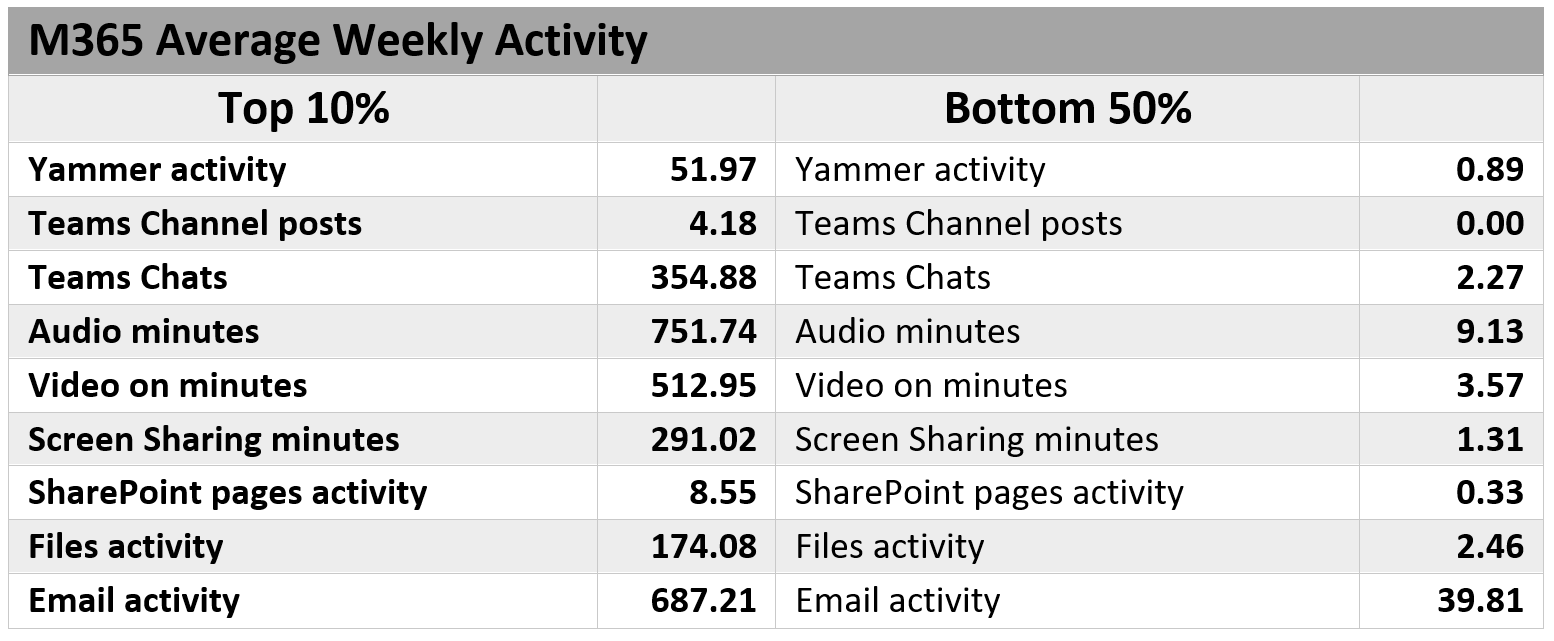All the gear and no idea
Microsoft 365 provides all the gear for digital collaboration but SWOOP Analytics’ world-first analysis of M365 shows many have no idea how to use it.
M365 is a market leading cloud-based office suite. M365 dominates the larger private and public company spaces with something like 87.5% market share. By any measure it’s a comprehensive suite of technology tools, covering virtually every aspect of digital office work. Yet what we found was a huge gap between a selected few high adopters and a much larger “long tail” of poor adopters.
We analysed M365 collaborative interactions from the activity reports of more than 100,000 active users across 3,773 group/teams and 18 organisations over a six-month period. The adoption pattern shown below for time spent in meetings or calls is typical of each digital activity signal we analysed:
The above histogram divides the population of more than 100,000 users into percentiles based on the time spent in calls or meetings each day. It shows the busiest 10% accounted for almost half the total time spent, while the bottom 50% of staff accounted for only 6% of time spent. In fact, 18% spent no time in meetings at all!
The following table provides the data for the top 10% and bottom 50% for each signal we analysed:
While the popular press has been quick to report on the technology exhaustion being potentially experienced by the busiest 10% of staff, the low adopting 50% remain largely invisible. These staff are less likely to respond to workplace surveys. Their ability to “fly under the radar” is facilitated by no longer being required to be present in the office.
To be fair, with the exception of Files Activity, the signals we monitored relate to staff interacting with each other. The period of analysis was the six months to the end of March 2022, where staff were still largely working remotely. We acknowledge that job roles exist where solo workers can do their work with little need to interact with other staff. We believe this is very much a diminishing situation. And one could argue that even solo workers should be interacting with their line managers to some degree.
Is there a technology competency gap?
When we first saw these figures, we immediately thought about those previously office-bound leaders, managing by walking around, with little need to be digitally adroit. It turns out this wasn’t the case. Using job titles we were able to partition our population into “leaders” and “non-leaders”. What we found when assessing their SWOOP Collaboration Habits performance, leaders performed 25% higher than non-leaders. Perhaps the leaders were motivated by having to become more digitally skilled if they were to still do their jobs, when staff moved to working from home (WFH).
Sarah Franklin, writing for Forbes magazine suggests the pandemic has widened the skills gap. She suggests; “tech companies have an ethical responsibility to bring others along to share in the wealth they’re creating”, by providing support and training on the new tools they are providing. Vala Afshar, writing for Znet, cites research that indicates three out of four professionals do not feel ready to work in a digital-first world. Management consultant firm PWC’s global workforce survey found staff felt training opportunities were being provided only to staff with already high levels of skills.
It does appear that our analyses are consistent with what workforce commentators are finding from their surveys.
How can analytics help bridge the gap?
We see our SWOOP consulting partners are busy helping to plug the training gap identified above. However, when we look at the numbers; 50,000 staff from our own sample population, formal training and coaching sessions will not be sufficient. The PWC survey, cited above found 77% of remote working staff were ready to learn new skills. Unlike the “leaders” we identified, perhaps the motivation for “non-leaders” to become more proficient with the different M365 tools is not as strong, with many happy to work under the radar.
Our preference for addressing the skills gap is for more peer-to-peer learning. Our M365 benchmarking analysis of 3,773 teams/groups showed a majority have at least some members who demonstrate high levels of digital working competency. We assessed each team member for their digital working competence based on SWOOP’s Seven Collaboration Habits and then averaged the performance across the team. We also measured the variance in digital habit performance across the team and plotted this variance against the average performance:
The dominant pattern was the inverse relationship between the variability of digital competency within the team, and its collaboration performance i.e. the less variability, the stronger the performance. There was also a smaller number of teams that also showed low variance, but with low collaborative performance. We see these groups or teams as the poorest adopters of M365, with inactivity being the common denominator i.e. the team members have no idea about how to use M365. We identify this grouping as prime candidates for formal training/coaching; preferably learning as a team.
The graph shows that once the average performance of a team reaches a certain level (around the 50% mark), the mix of skilled and unskilled members is such that peer-to-peer coaching can become effective. Such coaching will create team norms for collaboration within the team, leading to higher overall collaborative performance.
What can SWOOP for M365 do to help?
SWOOP for M365 reports on digital habits at the individual, business segment and enterprise levels:
Business segments can be any profile attribute recorded in the M365 active directory. The average digital habits performance is reported for review by the team. Areas of below average performance can therefore be addressed by adjusting the team norms. For example, in the graphic above we can see a below average performance for the “File Sharer” habit, meaning some team members are preferencing the use of private OneDrive stores over team-sharable SharePoint stores. This can easily be addressed by the collective agreement of the team to preference SharePoint stores over OneDrive.
Individual digital habits performance are available and privacy protected. Team members can quickly identify if they are the culprit for a below average score and make personal adjustments to their habits, as appropriate.
For those teams in the poor M365 adopters segment, formal team trainers/coaches can make use of the segment dashboard to monitor improvements over time. M365 analytics encourages teams to form formal “digital teams” within Microsoft Teams, thereby gaining access to hub applications and Microsoft Teams channels. Once established as a team in Microsoft Teams, SWOOP for Teams provides deeper team relationship-centred analytics for optimising team culture and performance.
With the help of SWOOP, we can have “All the gear, and all the cheer”.






